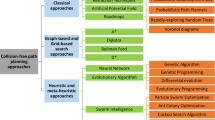Abstract
In this study, a sliding mode controlled dual arm robotic system was designed. Such multi-arm, collaborative and synchronous robots typically are employed in hazardous situations such as radioactive materials transport explosives disposal and industrial applications. In the present study, a high performance, robust, non-chattering sliding mode controller (SMC) was developed for the purpose of safe load handling, transportation and trajectory realization. First, dynamic equations of robot/load interaction were derived. Then, the robust SMC was designed for the dual arm robotic system. In order to test the robustness of the proposed SMC, parameter variations and external disturbances were introduced to the system. Furthermore, for comparative purposes, the conventional and widely used, PID controller was also applied to the dual arm robot. Significantly, it was found that the SMC made smaller trajectory tracking errors than the PID controller. An overall analysis of the numerical results confirmed that the dual-arm robotic systems with the proposed SMC can safely and effectively be used in hazardous applications.
Similar content being viewed by others
References
Y. F. Zheng and J. Y. S. Luh, Optimal load distribution for two industrial robots handling a single object, IEEE International Conference on Robotics and Automation, Philadelphia, USA (1988) 344–349.
P. Dauchez, X. Delebarre, Y. Bouffard and E. Degoulange, Task modeling and force control for a two-arm robot, IEEE International Conference on Robotics and Automation, Sacramento, California, (1991) 1702–1707.
Q. Xue, A. A. Maciejewski and P. C.-Y. Sheu, Determining the collision-free joint space graph for two cooperating robot manipulators, IEEE Transactions on Systems, Man, and Cybernetics, 23(1) (1993) 285–294.
A. Kron and G. Schmidt, Haptic telepresent control technology applied to disposal of explosive ordnances: Principles and experimental results, IEEE International Symposium on Industrial Electronics, Dubrovnik, Croatia (2005) 1505–1510.
C. R. Carignan and D. L. Akin, Cooperative control of two arms in the transport of an inertial load in zero gravity, IEEE Transactions on Robotics and Automation, 4(4) (1988) 414–419.
A. S. Al-Yahmadi, J. Abdo and T. C. Hsia, Modeling and control of two manipulators handling a flexible object, Journal of the Franklin Institute, 344 (2007) 349–361.
J.-F. Liu and K. Abdel-Malek, Robust control of planar dualarm cooperative manipulators, Robotics and Computer Integrated Manufacturing, 16 (2000) 109–119.
M. Uchiyama, N. Iwasawa and K. Hakomori, Hybrid position/force control for coordination of a two-arm robot, IEEE International Conference on Robotics and Automation, Raleigh, USA (1987) 1242–1247.
K. Laroussi, H. Hemami and R. E. Goddard, Coordination of two planar robots in lifting, IEEE Journal of Robotics and Automation, 4(1) (1988) 77–85.
S.-T. Lin and A.-K. Huang, Position-based fuzzy force control for dual industrial robots, Journal of Intelligent and Robotic Systems, 19(4) (1997) 393–409.
V. I. Utkin, Variable structure systems with sliding modes. IEEE Transactions on Automatic Control 22 (1977) 212–222.
N. Yagiz and Y. Hacioglu, Fuzzy sliding modes with moving surface for robust control of a planar robot, Journal of Vibration and Control, 11(3) (2005) 903–922.
P. Herman, Sliding mode control of manipulators using first-order equations of motion with diagonal mass matrix, Journal of the Franklin Institute, 342 (2005) 353–363.
M. L. Corradini and G. Orlando, Control of mobile robots with uncertainties in dynamical model: a discrete time sliding mode approach with experimental results, Control Engineering Practice, 10 (2002) 23–34.
S. Yannier, A. Sabanovic, A. Onat and M. Bastan, Sliding mode based obstacle avoidance and target tracking for mobile robots, Proceedings of the IEEE International Symposium on Industrial Electronics, June 20–23, Dubrovnik, Croatia (2005) 1489–1494.
G. Herrmann, S. K. Spurgeon and C. Edwards, A model-based sliding mode control methodology applied to the HDA-plant, Journal of Process Control, 13 (2003) 129–138.
E. M. Jafarov and R. Tasaltin, Robust sliding mode control for the uncertain MIMO aircraft model F-18, IEEE Transactions on Aerospace and Electronic Systems, 36(4) (2000) 1127–1141.
J. H. Park and Y. J. Lee, Robust visual servoing for motion control of the ball on a plate, Mechatronics, 13(7) (2003) 723–738.
C. Edwards and S. K. Spurgeon, Sliding Mode Control: Theory and Applications, Taylor & Francis (1998).
Q. P. Ha, D. C. Rye and H. F. Durrant-Whyte, Fuzzy moving sliding mode control with application to robotic manipulators, Automatica, 35 (1999) 607–616.
V. Utkin, J. Guldner and J. Shi, Sliding Mode Control in Electromechanical Systems, Taylor & Francis (1999).
Author information
Authors and Affiliations
Corresponding author
Additional information
This paper was recommended for publication in revised form by Associate Editor Doo Yong Lee
Nurkan Yagiz received his B.S. and M.S. degrees from the Department of Mechanical Engineering, Middle East Technical University, Ankara, Turkey, in 1984 and 1986, respectively, and his Ph.D. degree from the Department of Mechanical Engineering, Faculty of Engineering, Istanbul University, Istanbul, Turkey, in 1993. He is currently a Professor with the Department of Mechanical Engineering, Faculty of Engineering, Istanbul University. His research areas include modeling and control of vehicle systems, control of structural vibrations, and nonlinear control theory.
Yuksel Hacioglu received his B.S., M.S. and Ph.D. degrees from the Department of Mechanical Engineering, Faculty of Engineering, Istanbul University, Istanbul, Turkey, in 2002, 2004 and 2009, respectively. He is currently an Assistant Professor with the Department of Mechanical Engineering, Faculty of Engineering, Istanbul University. His research areas include modeling and control of robotic manipulators and vehicle suspension systems, nonlinear control theory, and fuzzy logic.
Yunus Ziya Arslan received his B.Sc. degree in 2002, his M.Sc. degree in 2005 and his Ph.D. degree in 2009, all from the Department of Mechanical Engineering, Faculty of Engineering, Istanbul University, Istanbul, Turkey. He is currently an Assistant Professor with the Department of Mechanical Engineering, Faculty of Engineering, Istanbul University. His research areas include biomechanics of musculoskeletal systems, as well as modeling and control of robotic manipulators.
Rights and permissions
About this article
Cite this article
Yagiz, N., Hacioglu, Y. & Arslan, Y.Z. Load transportation by dual arm robot using sliding mode control. J Mech Sci Technol 24, 1177–1184 (2010). https://doi.org/10.1007/s12206-010-0312-9
Received:
Revised:
Accepted:
Published:
Issue Date:
DOI: https://doi.org/10.1007/s12206-010-0312-9




